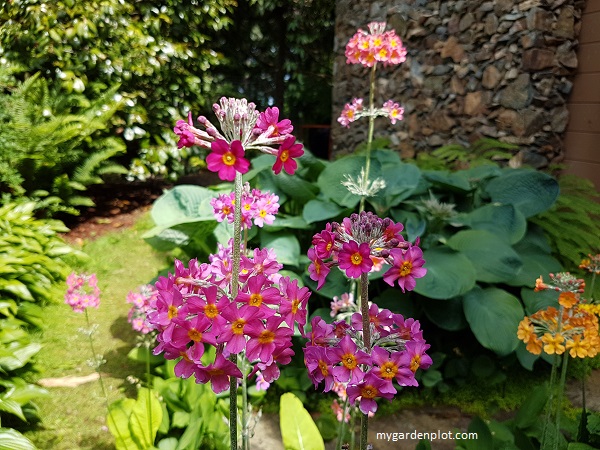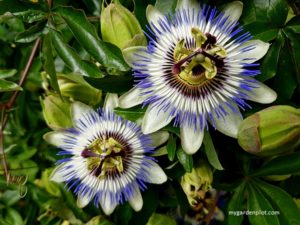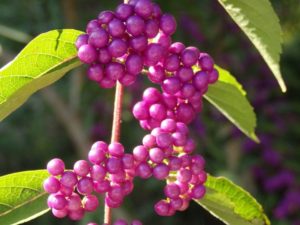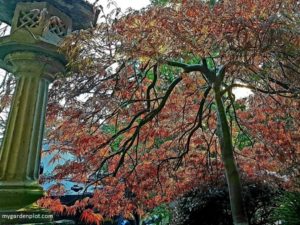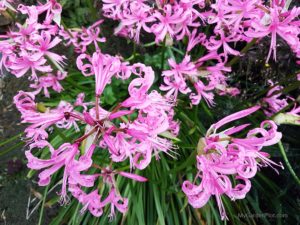About Proliferae / Candelabra Primula (Candelabra Primrose)
The primula candelabra group is one of the most elegant species of the primrose family. Most are native to the Himalayas and East Asia. Here are our tips on where to plant and how to grow and care your candelabra primulas.
Candelabra Primulas (Candelabra Primroses) are known for their distinctive tiered flower arrangements resembling a candelabrum. These herbaceous perennials feature tall, upright stems (12-24 inches) with multiple whorls of flowers stacked in tiers. Their architectural flower spikes add vertical interest. Flowers appear in late spring to early summer, with colors ranging from pink, purple, and red to yellow and orange. Each stem produces several layers of flowers. Some species exhibit color gradation as blooms age. The foliage are rosettes of lance-shaped, often toothed leaves form a basal clump.
They are often selected for boggy garden beds or moisture-retentive soil conditions, adding vibrant colour and architectural interest in a border. Candelabra primrose thrive in high humidity and cool temperatures. Ideal near water features, stream banks, moist-rich meadows or woodland areas with dappled shade.
They attract hummingbirds, bees and butterflies, and other beneficial insects to your moisture-loving garden. And they are deer and rabbit resistant.
The candelabra primroses are easy to care for, long-lived, hardy perennials. These dependable primroses have unique long stems with flowers borne on several whorls, from two to eight, per stem. Depending on the candelabra primrose species, these tiered blossoms can last from mid-spring through to early summer.
These show best planted in groups and mixed colours, which can range from pink, purple and red to yellow and orange. In our garden, we have them grouped along with the hostas and western maidenhair ferns. Pair with astilbes (false goat’s beard) and ligularias (leopard plant) for a cohesive moisture-loving garden.
Candelabra Primulas are a captivating choice for gardeners seeking to enhance moist, shaded areas with vibrant, layered blooms. Their ease of care and striking appearance make them a standout in temperate climates. By following these guidelines, candelabra primroses will flourish, adding colour and structured beauty to your shaded garden location.
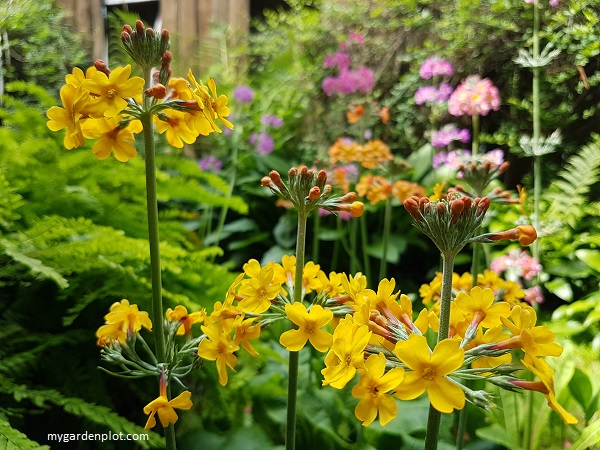
Candelabra Primulas (Candelabra Primroses) At A Glance
Type: Decidous / Herbaceous Perennials / Semi-evergreen
Location: Partial shade; tolerates morning sun if soil remains damp
Seasonal Interest: Mid spring to early summer flowers
Flowers: Tall, tiered blooms in multiple vibrant colours of pink, orange and yellow
Size: Height varies 30-90 cm (1-3 ft)
Cold Hardiness Zones: 4, 5, 6, 7, 8, 9 (zones 4 – 7 will need mulch in winter for root protection)
Where To Plant And How To Care For Candelabra Primulas (Candelabra Primroses)
Plants that generally like bog gardens thrive in soggy soil but prefer not to be ‘bathing’ in standing water. The candelabra Primula group is no different. Most are water-loving primroses that prefer cool summers. They thrive in moisture-retentive, humus-rich soil that is slightly acidic to neutral pH 5.5-7.0. Keep soil evenly moist. Water regularly, especially in dry spells in summer but avoid waterlogging to prevent root rot.
Plant in a partially shady location away from the hot summer sun, but not in deep shade. They do well in a north-facing shady wet border, damp woodland garden or at the edge of a stream or pond. It will tolerate morning sun if soil remains moist but avoid intense afternoon sun.
Candelabra primulas are low maintenance clump-forming plants that happily self-seed year after year. If they start growing where you don’t want them to grow in, they are easy to remove.
Add rich organic matter and mulch in late winter or by early spring to feed and help prevent the soil from drying out and regulate soil temperature. This helps to keep their roots cool during any intense summer days. Mulching also helps suppress weeds. Care should be taken to ensure the soil never dries out. They are not tolerant to dry conditions. Ensure these primroses receive regular water throughout the summer.
Apply a balanced fertilizer (10-10-10) lightly in early spring. Avoid high-nitrogen fertilizers to prevent leafy growth over blooms.
Remove spent flowers to encourage blooming and prolong the flowering season. When they have finished their cycle of flowering, you can remove the stems with the wilted flowers – allow some to self-seed if desired.
Remember to collect seeds after flowering or leave blooms to self-seed. If you are growing Candelabra primula from seed, it is important to surface sow to allow light to aid germination for best results. Cold stratification will be needed – this is a process that involves exposing seeds to cold, moist conditions to help seeds germinate. Propagation by seed may take 2 years to flower. Patience is key.
Divide clumps every 3-4 years in early spring or post-flowering in autumn to prevent overcrowding.
Winter care is minimum. In colder regions where cold temperature fluctuates, leave the faded leaves to help insulate the primrose root zone or add mulch for root protection. In milder climates, some candelabra primulas keep their leaves green through to winter, at which time they die back. At the end of winter, remove any remaining dead foliage or faded old leaves and tidy the area from any dead matter to be ready for regrowth in spring.
They will reliably return year after year.
RELATED TOPIC: Buyer’s Guide On How To Choose Hand Pruners (Secateurs)
Pests, Disease and Troubleshooting
Candelabra primulas need moist soil conditions and will die if allowed to dry out. Ensure good drainage to prevent root rot from waterlogging.
Prevent powdery mildew with good air circulation, and avoid overhead watering if possible.
Occasionally root weevil larvae can affect them by burrowing into their roots, and slugs and snails may take a nibble. Combat slugs or snails with organic pellets or bait. Susceptible to aphids – use insecticidal soap if affected by aphids.
Otherwise, they are generally trouble-free, and are deer and rabbit resistant.
Recommended Candelabra Primrose Varieties
P. beesiana – The flowers of the P. beesiana are deep pink or reddish-purple colour with yellow centres or ‘eyes’. The P. beesiana is native to China. Height and spread is around 30 x 20 cm (12 x 8 in).
P. bulleyana – Also native to China, the P. bulleyana is semi-evergreen. Initially, the buds are orange or red, but the flowers that emerge range from yellow and orange to pink and red. Height and spread is about 50 x 20 cm (20 x 8 in).
P. japonica – The P. japonica, or Japanese primrose, has purple or pink flowers with dark eyes. There is a pretty variety with white flowers and a yellow centre. As the name implies, P. japonica is native to Japan. Height and spread generally 40 x 20 cm (16 x 8 in).
P. prolifera – The P. prolifera (syn. P. helodoxa) has fragrant flowers that vary from light to dark yellow. Originally from Northeast India, Myanmar, South China, Malaysia and Java (Indonesia). Height and spread is around 60 x 20 cm (24 x 8 in).
P. pulverulenta – The P. pulverulenta is native to China and has deep red, pink or purple flowers with darker eyes. These have a distinctive wrinkled leaf form and whitish stem. Height and spread is generally 80 x 20 cm (32 x 8 in).
RELATED TOPIC: Spring Gardening Highlights And Plant Recommendations

